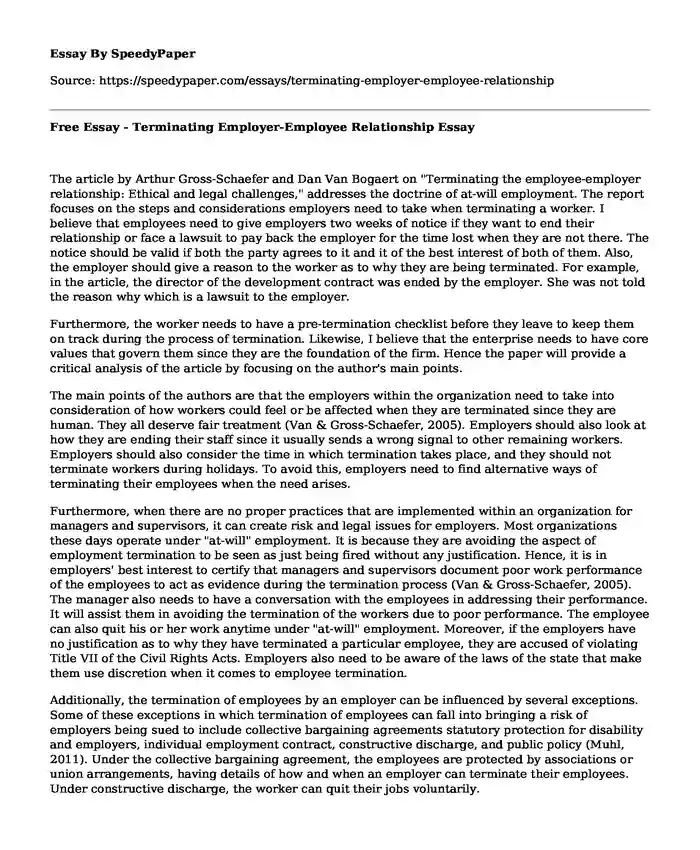
| Type of paper: | Article review |
| Categories: | Relationship Organizational behavior Business communication Employment law |
| Pages: | 4 |
| Wordcount: | 865 words |
The article by Arthur Gross-Schaefer and Dan Van Bogaert on "Terminating the employee-employer relationship: Ethical and legal challenges," addresses the doctrine of at-will employment. The report focuses on the steps and considerations employers need to take when terminating a worker. I believe that employees need to give employers two weeks of notice if they want to end their relationship or face a lawsuit to pay back the employer for the time lost when they are not there. The notice should be valid if both the party agrees to it and it of the best interest of both of them. Also, the employer should give a reason to the worker as to why they are being terminated. For example, in the article, the director of the development contract was ended by the employer. She was not told the reason why which is a lawsuit to the employer.
Furthermore, the worker needs to have a pre-termination checklist before they leave to keep them on track during the process of termination. Likewise, I believe that the enterprise needs to have core values that govern them since they are the foundation of the firm. Hence the paper will provide a critical analysis of the article by focusing on the author's main points.
The main points of the authors are that the employers within the organization need to take into consideration of how workers could feel or be affected when they are terminated since they are human. They all deserve fair treatment (Van & Gross-Schaefer, 2005). Employers should also look at how they are ending their staff since it usually sends a wrong signal to other remaining workers. Employers should also consider the time in which termination takes place, and they should not terminate workers during holidays. To avoid this, employers need to find alternative ways of terminating their employees when the need arises.
Furthermore, when there are no proper practices that are implemented within an organization for managers and supervisors, it can create risk and legal issues for employers. Most organizations these days operate under "at-will" employment. It is because they are avoiding the aspect of employment termination to be seen as just being fired without any justification. Hence, it is in employers' best interest to certify that managers and supervisors document poor work performance of the employees to act as evidence during the termination process (Van & Gross-Schaefer, 2005). The manager also needs to have a conversation with the employees in addressing their performance. It will assist them in avoiding the termination of the workers due to poor performance. The employee can also quit his or her work anytime under "at-will" employment. Moreover, if the employers have no justification as to why they have terminated a particular employee, they are accused of violating Title VII of the Civil Rights Acts. Employers also need to be aware of the laws of the state that make them use discretion when it comes to employee termination.
Additionally, the termination of employees by an employer can be influenced by several exceptions. Some of these exceptions in which termination of employees can fall into bringing a risk of employers being sued to include collective bargaining agreements statutory protection for disability and employers, individual employment contract, constructive discharge, and public policy (Muhl, 2011). Under the collective bargaining agreement, the employees are protected by associations or union arrangements, having details of how and when an employer can terminate their employees. Under constructive discharge, the worker can quit their jobs voluntarily.
Also, at-will employment does not supersede a person's employment contract, which specifies a specified period for work. Its only way is by the use of the probationary period (Muhl, 2011). For public policy exceptions to at-will employment, the employee can be wrongly discharged if the termination is against the state's well-established, explicit public policy. The employer can no terminate a worker just because they belong to any of the protected groups. The anti-discrimination statutes tend to prevent the rights of employers to use the "at-will" doctrine. Hence employers need to be mindful of the decisions they take in regard to employee termination due to the availability of various exceptions.
Finally, the author discusses methods employees can take in terminating employees and some of the vital guidelines I believe employers need to follow. First, the authors indicate that employees need to be compensated after termination (Walsh, 2016). Also, employees should be treated with respect and dignity regardless of the event and they deserve to know the reason for their termination. The employees should also be given advance notice of the termination to pre them for what may come. The workers should also receive severance pay according to the company policy.
References
Muhl, C. J. (2011). The employment-at-will doctrine: three major exceptions. Retrieved from https://www.bls.gov/opub/mlr/2001/01/art1full.pdf
Van Bogaert, D., & Gross-Schaefer, A. (2005). Terminating the employee-employer relationship: Ethical and legal challenges. Employee Relations Law Journal, 31(1), 49-66. Retrieved from https://libraryresources.columbiasouthern.edu/login?url=http://search.ebscohost.com/login.aspx?direct=true&db=bth&AN=17091666&site=ehost-live&scope=site
Walsh, D.J.W. (2016). Terminating Individual Employees. In Walsh, D.J.W (Ed), Employment Law for Human Resource Practice (pp. 449-452). Massachusetts: Cengage Learning
Cite this page
Free Essay - Terminating Employer-Employee Relationship. (2023, Mar 30). Retrieved from https://speedypaper.net/essays/terminating-employer-employee-relationship
Request Removal
If you are the original author of this essay and no longer wish to have it published on the SpeedyPaper website, please click below to request its removal:
- Free Essay on Initial Mental Health Post Arrest Assessment
- Free Essay on Tourism and Climate Change
- Free Essay about Revenue Recognition
- Essay Example: Therapeutic Group Experience
- Free Essay with a Briefing Note to Improve the Quality of Lives of the Elderly Who Live Alone
- Essay Sample on a Discussion on Human Learning
- What Is Needed to Be Able to Start a Small Business? Essay Sample
Popular categories




